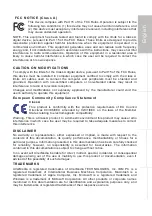
Triggering
158
Goldeye G/CL Technical Manual V4.1.1
Communication takes place at a bandwidth of up to 115,200 baud (customer
adjustable).
Isolated out power (pin 10)
Connect the
Isolated Out Power
to a power source for isolated signals
Out 2
and
Out 3
. The voltage requirement is 3 to 30 VDC. The current requirement for this
supply is a function of the optical insulator collector current and the number of
outputs used in the system.
Isolated Out Power
wiring should be physically close
to
Out 2
/
Out 3
wiring to prevent parasitic coupling.
Input signals
Input signals allow the camera to be synchronized to an external event. The
camera can be programmed to trigger on the rising edge, falling edge, both edges,
or level of the signal. The camera can also be programmed to capture an image at
some programmable delay time after the trigger event.
In 1 - non-isolated (pin 4)
In 1
is not electrically isolated and can be used when environmental noise is
inconsequential, and a faster trigger response is required. To complete the trigger
circuit, connect trigger ground to External GND.
More information on the RS232 interface:
For complete RS232 description and usage on GigE cameras, see the application
note RS232 Port Explained on the Allied Vision Knowledge base web page:
https://www.alliedvision.com/en/support/technical-papers-knowledge-
base.html
Trigger signal
Input current
Required trigger signal:
LVTTL (3.3 V), TTL (5 V) tolerated
Input current to be expected in TTL mode:
3 mA
Input current to be expected in LVTTL mode: 0.3 mA
Table 110: Input 1 ‐ trigger signal and input current
i
















































